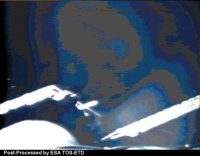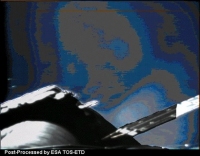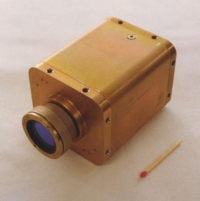Jets in space : XMM unique pictures
16 December 1999
During the XMM early orbit phase manoeuvres, which have raised the orbit perigee to 7000 km, small micro-cameras on the outside of the spacecraft have been able to take exceptional views of XMM and of its thrusters in action.Views of thruster jets working in space are very rare. The first date back to the first US manned capsule flights (Gemini, Apollo) and more recently have been photographed on Shuttle missions. Views of rocket stages separating and satellite releases also exist. But placing piggy-back micro-cameras on spacecraft is a relatively new practice and the views of a spacecraft thrusters working in space are a rare occurrence.
The two small Visual Monitoring Cameras (VMC) are situated on XMM's focal plane assembly. Named FUGA and IRIS, the cameras look along each side of the 7m telescope tube towards the service module and solar arrays. Provided by OIP - Delft Sensor Systems, and IMEC, Belgium the cameras and electronics measure 10 x 6 x 6 cm and each weigh 430 grams.
The thruster unit on the service module appears as a protuberance behind the black thermal insulation and it occults part of the edge of the telescope sunshield. The first picture shown here was taken by IRIS (with an exposure of 14 ms) during the second firing of XMM's thrusters on 11 December at 15:22 CET.
During the firing, the thruster nozzles expel gas at high velocity which develops as a cloud, also called a plume. This is clearly visible in two lobes, of different sizes, one upwards and one slightly to the right.
 |
 |
|
11 December at 15:22 CET |
11 December at 16:47 CET |
The second picture, obtained with the same IRIS camera was taken some 56 minutes after the completion of the Perigee Raise Manoevres on 11 December at 16:47 CET. The expelled gas can still be seen as a cloud around the spacecraft. Both images have been processed to enhance the visibility of the gas. Detailed analyses of those pictures will help propulsion engineers to better visualise the expansion of the gas cloud at the exit of the thrusters.
The hydrazine propulsion system on XMM consists of eight 22 Newton thrusters (in two redundant sets) made by DASA-RI. The spacecraft had been fuelled with 530 kg of monopropellant grade Hydrazine before launch. Some 400 kg will have been consumed to reach the operational orbit, the remainder will amply serve XMM for the rest of its 10 year mission life.
The cameras
The VMC cameras were developed under ESA funding by OIP (Optronic Instruments and Products) - Delft Sensor Systems, part of Delft Instruments, Delft Netherlands. OIP, based in Oudenaarde Belgium, worked on this project with subcontractor IMEC (Interuniversity Microelectronics Centre) Leuven Belgium.
 |
|
The Visual Monitoring Camera |
OIP has already worked on several space projects and successfully developed hardware for the Spacelab IML-1 and IML-2 missions and for EUREKA. VTS cameras, precursors to the VMC cameras, were successfully used on the Ariane 502 flight.
The VMC cameras utilize CMOS Active Pixel Sensors, developed by IMEC. They are stand alone digital units, featuring a choice of interfaces, sensors, colour or greyscale and exchangeable optics. The camera accepts image capture and exposure control commands, performs the image acquisition and stores the image in a local memory buffer to facilitate readout at a low data rate.
The IRIS camera, which is flying for the first time in space on XMM, has a 400 x 310 field of view and provides colour pictures in a range 570-740 nm. The FUGA camera with a 290 x 290 field of view provides black and white images, wavelength range 570-740 nm.

